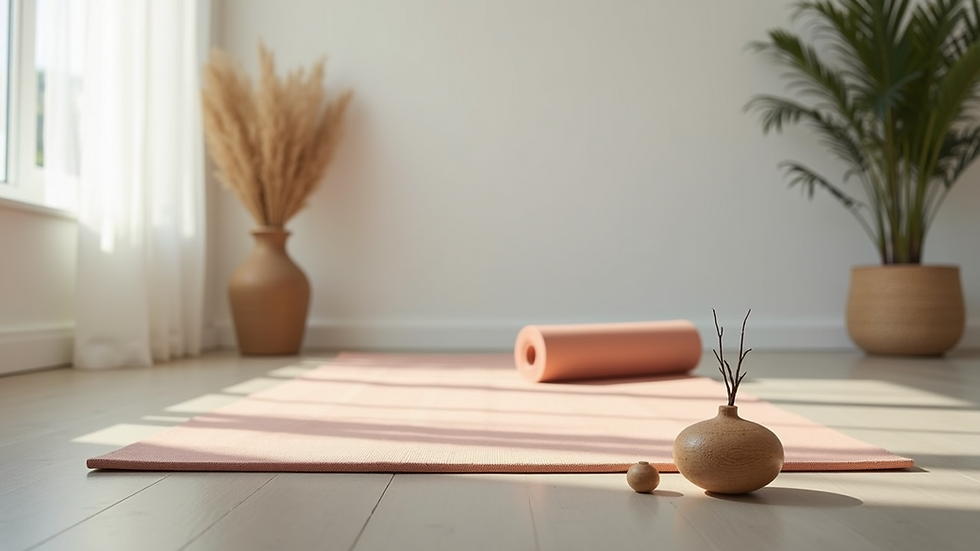How Gentle Yoga Can Help You Unwind
- Sarah Callus
- Oct 27
- 4 min read
In today’s fast-paced world, finding ways to relax and unwind is more important than ever. Gentle yoga offers a calming and accessible approach to help you reduce stress and improve your overall well-being. Unlike more intense forms of yoga, gentle yoga focuses on slow movements, deep breathing, and mindful awareness. This makes it ideal for people of all ages and fitness levels who want to experience the benefits of yoga without pushing their bodies too hard.
What Is Gentle Yoga and Why Is It Beneficial?
Gentle yoga is a style of yoga that emphasises slow, deliberate movements and poses that are easy to hold. It often incorporates breathing exercises and meditation to promote relaxation. This form of yoga is perfect for beginners, those recovering from injury, or anyone looking for a softer approach to physical activity.
Some key benefits of gentle yoga include:
Improved flexibility: The slow stretches help lengthen muscles and increase joint mobility.
Better posture: Gentle yoga encourages body awareness and alignment.
Reduced muscle tension: Holding poses gently can release tightness and stiffness.
Enhanced mental calmness: The focus on breath and mindfulness helps quiet the mind.
Increased energy: Relaxation and improved circulation can boost vitality.
Because gentle yoga is low-impact, it is less likely to cause strain or injury. This makes it a sustainable practice for long-term health and stress management.

How Gentle Yoga Supports Stress Relief
Stress is a common challenge that affects both the body and mind. Gentle yoga offers a natural way to counteract stress by activating the parasympathetic nervous system - the part responsible for rest and digestion. This helps lower heart rate, reduce blood pressure, and calm the nervous system.
Practising gentle yoga regularly can:
Lower cortisol levels: Cortisol is the hormone released during stress. Yoga helps regulate its production.
Improve sleep quality: Relaxing poses and breathing techniques prepare the body for restful sleep.
Enhance mood: Yoga stimulates the release of endorphins, the body’s natural feel-good chemicals.
Increase mindfulness: Being present during yoga reduces rumination and worry.
If you want to explore more about stress relief yoga, there are many online resources and classes designed specifically to help you unwind and find balance.
Does Yoga Really Relieve Stress?
Many people wonder if yoga truly helps with stress or if it’s just a trendy exercise. Scientific studies have shown that yoga can be an effective tool for managing stress and anxiety. For example, research indicates that yoga reduces symptoms of anxiety disorders and improves overall emotional well-being.
The combination of physical movement, breath control, and meditation in yoga creates a holistic approach to stress relief. Unlike some forms of exercise that may increase adrenaline, gentle yoga encourages relaxation and recovery.
Moreover, yoga’s emphasis on mindfulness teaches you to observe your thoughts without judgment. This skill can help break the cycle of negative thinking that often accompanies stress.
In practical terms, even a short daily session of gentle yoga can make a noticeable difference in how you feel. Starting with just 10-15 minutes can help you build a habit that supports long-term stress management.

Practical Tips for Starting Gentle Yoga at Home
If you’re new to gentle yoga, here are some simple steps to get started:
Choose a quiet space: Find a calm area where you won’t be disturbed.
Use a yoga mat or soft surface: This provides comfort and stability.
Wear comfortable clothing: Loose, breathable clothes allow free movement.
Start with basic poses: Focus on gentle stretches like child’s pose, cat-cow, and seated forward bend.
Incorporate breathing exercises: Try deep belly breathing or alternate nostril breathing.
Set a regular schedule: Consistency helps build the habit and maximise benefits.
Listen to your body: Avoid pushing into pain or discomfort.
Use online resources or apps: Guided sessions can provide structure and motivation.
Remember, the goal is to relax and enjoy the process, not to achieve perfect poses. Over time, you may notice improvements in flexibility, mood, and stress levels.
Integrating Gentle Yoga Into Your Daily Routine
Making gentle yoga a part of your daily life can be simple and rewarding. Here are some ideas to help you integrate it seamlessly:
Morning ritual: Start your day with 10 minutes of gentle stretches to awaken your body.
Work breaks: Use short yoga breaks during the day to relieve tension from sitting.
Evening wind-down: Practice calming poses before bed to prepare for restful sleep.
Mindful moments: Combine yoga with meditation or journaling for deeper relaxation.
Social practice: Join a gentle yoga class or group to stay motivated and connect with others.
By incorporating gentle yoga into your routine, you create a dedicated time for self-care and stress relief. This can improve your resilience to daily challenges and enhance your overall quality of life.
Gentle yoga offers a powerful yet accessible way to unwind and nurture your body and mind. Whether you are new to yoga or looking for a softer practice, gentle yoga can help you find calm, improve flexibility, and reduce stress. With regular practice and mindful attention, you can create a peaceful space within yourself that supports well-being every day.



Comments